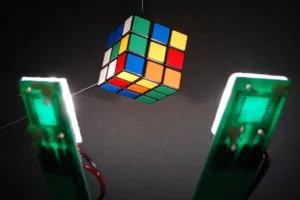The quality of light from modern electronics leaves much to be desired, according to a research team at Arizona State University (ASU), which hopes to make these products mimic natural light more closely.
This image of single-doped OLEDs, shining white light on to a Magic Cube, shows how OLEDs can vividly illuminate the colours of the cube across the full range of the visible colour spectrum.OLEDs are one area that the team is focusing on. The new types of OLED produced would not emit ultraviolet (UV) light. Such a development would enable clearer vision, said team lead Jian Li, and prevent eyestrain. UV light prevents the human eye from clearly discerning colour variations and the texture of objects. Over time, it can also dull colours in paintings – so these OLEDs would have applications in museums, for example.
Li’s lab is working with Universal Display Corporation (UDC), with a grant from the USA’s Department of Energy. They are working to develop OLEDs that use a single emissive material to create a white emission, rather than multiple colours. This type of device is less complex and more operationally stable.
Achieving this requires the development and use of a unique class of emissive materials. These can produce a blue emission in a single molecular form, or an orange emission with two molecules stacked. Precise control of these emissions can produce a ‘high-quality’ white light for indoor illumination.
If successful, the new OLED devices would be less complicated and cheaper to manufacture. They would also be more efficient than today’s OLEDs, with a longer lifespan, as they would require less power.

